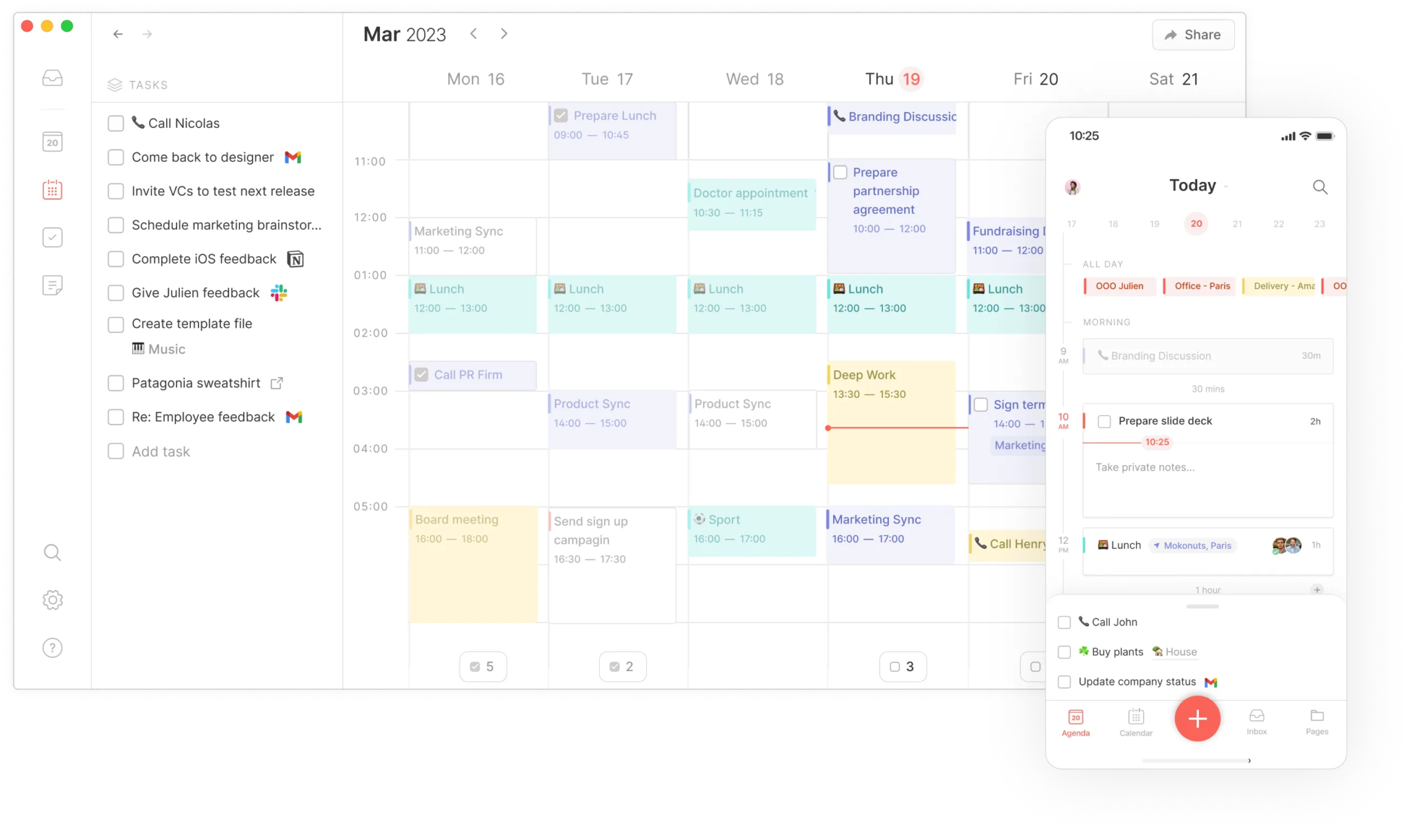Back to all comparisons
Routine vs Asana
Comprehensive comparison to help you choose the right tool for your needs

Routine
4.5
Routine is a productivity app combining tasks, notes, and calendar into a single interface. It's designed to simplify task management and note-taking, offering a streamlined approach to organizing daily activities.
$12 per month, annually
Visit Website 
Asana
4.8
Asana is a project management tool focused on team collaboration and work organization, offering multiple views for task management, app integrations, and AI features for efficiency. It's suitable for various team sizes, streamlining workflows and aligning goals.
Asana offers three plans: the free Personal plan for basic needs, the Starter plan at $11.59 for expanded features like timeline view, and the Advanced plan at $25.69 for comprehensive project management tools including time tracking and advanced customization.
Visit Website Quick Summary
Routine Strengths
- Timeline Agenda: Offers a detailed view of the day's plan with timestamps, including meeting and event reminders, with options to time-block tasks.
- Week Calendar: Provides a 5-day, week, and month view for task planning, integrating seamlessly with Google Calendar.
- Console Capture: A desktop feature for capturing events, notes, and tasks outside the application, ideal for GTD enthusiasts.
- Centralized Workspace: Combines tasks, notes, and calendar in one space.
Asana Strengths
- Task Management: Asana excels in task management, allowing users to create, assign, and track tasks efficiently. This feature ensures that team members are always aware of their responsibilities and deadlines, promoting productivity and accountability.
- Project Visualization: With options like Kanban boards and Gantt charts, Asana offers versatile visualization tools. These features aid in understanding the project flow and milestones, making it easier to manage timelines and resources.
- Team Collaboration: Asana fosters seamless team collaboration. It allows for easy communication within tasks, sharing of files, and updating progress, thus keeping everyone on the same page and enhancing teamwork.
- Integration Capabilities: The platform integrates with a wide range of other applications and tools, streamlining workflows and automating processes. This integration makes it a flexible tool that can adapt to various business ecosystems.
Routine Screenshot

Asana Screenshot

Feature Comparison
| Feature | Routine | Asana |
|---|---|---|
| Platforms | macOS, Windows, iOS, Android, Web | macOS, iOS, Android, Web, and Windows |
| Integrations | Syncs with multiple calendar services and task managers like Todoist and Google Tasks. | Google Drive, Slack, Zoho Cliq, Zapier, Jira, Zoom, Toggl Track, Loom, Harvest, Gmail |
| Calendar | Google Calendar, Notion, Slack, Zapier, Siri, Gmail | Yes |
| Task Management | No | Task creation and assignment, due date setting, progress tracking, project organization, tagging, comments, file attachments, task conversations |
| Natural Language Processing | Offers task creation with date assignment via drag-and-drop | Yes |
| Analytics | No | Yes |
| Time Blocking | Available | No |
| Time Zones | Yes | Yes |
| Scheduler | No | No |
| Notifications | Yes | Yes |
| Pricing | $12 per month, annually | Asana offers three plans: the free Personal plan for basic needs, the Starter plan at $11.59 for expanded features like timeline view, and the Advanced plan at $25.69 for comprehensive project management tools including time tracking and advanced customization. |
| Customer Support | Average | Average |
Video Overview
Routine Video
Asana Video
Routine Overview
Routine is a productivity tool that sets itself apart with its all-in-one approach, combining elements of task management, note-taking, and calendar integration into a single platform. Designed to cater to the needs of busy professionals and individuals seeking to streamline their organizational process, Routine offers a comprehensive solution for managing daily tasks, appointments, and notes. Its unique selling point is the integration of these features within an intuitive and user-friendly interface, making it easier for users to track their to-dos, schedule their days, and store important information in one place. This level of integration is particularly useful for those who prefer a unified system to manage various aspects of their work and personal life.
Pricing Details
(i) Free Version: Available for students and hobbyists, though with limited features. (ii) Professional Plan: Priced at $12 per month. (iii) Business Plan: Costs $15 per user per month. (iv) Believer Plan: Priced at $10 monthly or $8 per month for an annual commitment, totaling around $96 annually
Asana Overview
Asana stands out as a versatile project management tool, ideal for various team sizes. Its user-friendly interface, coupled with diverse features like task management, project visualization (including Kanban and Gantt charts), and robust team collaboration tools, makes it a top choice. Additionally, Asana's integration capabilities with other apps enhance workflow efficiency. Offering a range of pricing plans, including a free version for smaller teams, Asana caters to a broad spectrum of organizational needs. It's particularly recommended for its ease of use, extensive integrations, and comprehensive project management features.
Pricing Details
Asana offers three main pricing tiers: (i) Personal: This is a free plan, suitable for small teams or individuals. It includes basic project and task management features and supports collaboration with up to 10 team members. Users have access to unlimited tasks, projects, messages, and file storage. (ii) Starter: Priced at $11.59 per user per month, this plan builds on the Personal plan. It allows collaboration with up to 500 teammates and introduces additional features like timeline and Gantt chart views, along with the ability to use forms and automation. (iii) Advanced: At $25.69 per user per month, the Advanced plan includes all features from the lower tiers and adds functionalities such as goals, time tracking, proofing, approvals, and more advanced customization options. Each tier offers a range of features to accommodate different needs, from individual use to more complex team collaboration and project management requirements.
Routine Key Features
Timeline Agenda: Offers a detailed view of the day's plan with timestamps, including meeting and event reminders, with options to time-block tasks.
Week Calendar: Provides a 5-day, week, and month view for task planning, integrating seamlessly with Google Calendar.
Console Capture: A desktop feature for capturing events, notes, and tasks outside the application, ideal for GTD enthusiasts.
Centralized Workspace: Combines tasks, notes, and calendar in one space.
Organization: Utilizes categories and tags for better event and task management.
Daily Plan: Helps in crafting focused daily tasks and important events.
Asana Key Features
Task Management: Asana excels in task management, allowing users to create, assign, and track tasks efficiently. This feature ensures that team members are always aware of their responsibilities and deadlines, promoting productivity and accountability.
Project Visualization: With options like Kanban boards and Gantt charts, Asana offers versatile visualization tools. These features aid in understanding the project flow and milestones, making it easier to manage timelines and resources.
Team Collaboration: Asana fosters seamless team collaboration. It allows for easy communication within tasks, sharing of files, and updating progress, thus keeping everyone on the same page and enhancing teamwork.
Integration Capabilities: The platform integrates with a wide range of other applications and tools, streamlining workflows and automating processes. This integration makes it a flexible tool that can adapt to various business ecosystems.
Customization and Reporting: Asana offers extensive customization options, including custom fields and reporting features. These allow teams to tailor their project management experience and generate insightful reports for better decision-making.
User-Friendly Interface: The intuitive interface of Asana is designed for ease of use, making it accessible for teams regardless of their technical expertise. This simplicity ensures a smooth onboarding process and enhances overall user experience.
Conclusion: Which Tool Should You Choose?
Both Routine and Asana offer unique features and benefits for productivity and workflow management. The best choice depends on your specific needs, team size, and workflow preferences.
Choose Routine if:
- Timeline Agenda: Offers a detailed view of the day's plan with timestamps, including meeting and event reminders, with options to time-block tasks.
- Week Calendar: Provides a 5-day, week, and month view for task planning, integrating seamlessly with Google Calendar.
- Console Capture: A desktop feature for capturing events, notes, and tasks outside the application, ideal for GTD enthusiasts.
Choose Asana if:
- Task Management: Asana excels in task management, allowing users to create, assign, and track tasks efficiently. This feature ensures that team members are always aware of their responsibilities and deadlines, promoting productivity and accountability.
- Project Visualization: With options like Kanban boards and Gantt charts, Asana offers versatile visualization tools. These features aid in understanding the project flow and milestones, making it easier to manage timelines and resources.
- Team Collaboration: Asana fosters seamless team collaboration. It allows for easy communication within tasks, sharing of files, and updating progress, thus keeping everyone on the same page and enhancing teamwork.